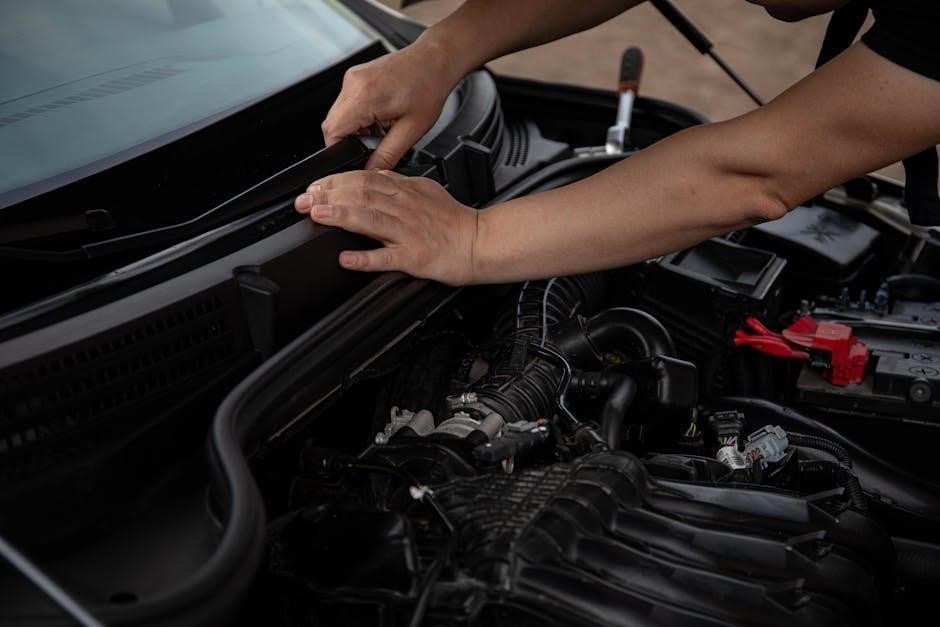Checking transmission fluid in a manual transmission is crucial for ensuring smooth gear shifts and preventing damage. Unlike automatic transmissions, manuals often lack a dipstick, making the process a bit more involved. This guide will walk you through how to check and maintain your manual transmission fluid effectively to keep your vehicle running smoothly and avoid costly repairs. Always take necessary safety precautions when working under your vehicle.

Why Checking Transmission Fluid is Important
Transmission fluid plays a vital role in ensuring the smooth operation of your vehicle’s manual transmission. It lubricates the gears, prevents overheating, and maintains hydraulic pressure necessary for proper gear function. Low fluid levels or degraded fluid can lead to poor shifting, grinding gears, and even complete transmission failure. Over time, transmission fluid can become contaminated or break down, reducing its effectiveness. Regular checks help identify issues early, preventing costly repairs. Signs of low or degraded fluid include delayed shifting, unusual noises, and overheating. Neglecting transmission fluid maintenance can result in premature wear on critical components, leading to expensive replacements. Ensuring the correct fluid level and condition is essential for maintaining your vehicle’s performance, reliability, and longevity. By monitoring transmission fluid, you can avoid unexpected breakdowns and ensure your manual transmission operates smoothly for years to come.

Gather Necessary Tools and Materials
To check the transmission fluid in your manual transmission, you’ll need a few essential tools and materials. These include a socket wrench or ratchet and socket set, as the fill plug is typically secured with a bolt. A drain pan is recommended to catch any fluid that may spill out during the process. Gloves and safety goggles are important for protecting yourself while working under the vehicle. You may also need a torque wrench to ensure the fill plug is properly tightened afterward. Additionally, have a clean rag on hand to wipe away any dirt or debris from the fill plug area. If you find the fluid level is low, you’ll need to purchase the correct type of transmission fluid specified in your vehicle’s owner’s manual. Always verify the fluid type to avoid damaging your transmission. These tools and materials will help you perform the check safely and effectively.

Locating the Transmission Fluid Fill Plug
To locate the transmission fluid fill plug on a manual transmission, refer to your vehicle’s owner’s manual for the exact position, as it varies by make and model. Typically, it is found on the driver’s side of the transmission, near the midpoint of the vehicle. Ensure the car is on level ground before attempting to locate and remove the plug to check the fluid level accurately.
Safety Precautions

Before checking the transmission fluid in your manual transmission, ensure your vehicle is parked on a level surface with the parking brake engaged. Put the car in neutral gear to prevent any accidental movement. Use jack stands for added safety when lifting the vehicle. Wear protective gloves and eyewear to prevent injury from potential spills or debris. Always refer to your owner’s manual for specific instructions and torque specifications to avoid damaging the transmission or fill plug. Proper safety measures will help ensure a successful and injury-free maintenance process.
Positioning the Vehicle

Park your vehicle on a level, flat surface to ensure accurate fluid level readings. Avoid inclines or uneven ground, as this can lead to incorrect measurements. Engage the parking brake and shift the transmission into neutral to prevent any movement during the process. Turn off the engine and allow it to cool slightly to avoid burns from hot components. Proper positioning is essential for safely accessing the transmission fill plug and obtaining an accurate fluid level assessment. Always follow these steps carefully to ensure a smooth maintenance process.

Removing the Fill Plug
Use a socket wrench to remove the fill plug located on the side of the transmission. Be prepared for any fluid spillage and use a drain pan if necessary. Ensure the area is clear and wear gloves for protection.
Checking the Fluid Level
To check the transmission fluid level on a manual transmission, start by ensuring the car is parked on a level surface with the engine warm. Locate the fill plug, typically on the driver’s side of the transmission. Remove the fill plug using a socket wrench. Be prepared for any fluid spillage by having a drain pan ready. Once the plug is removed, the fluid level should be visible at the bottom of the fill hole. If the fluid is below this level, it indicates a need to add more fluid. Inspect the fluid’s condition; it should appear clear or reddish-pink. If it looks dark or dirty, a fluid change may be necessary. Use a lint-free cloth to clean any spills and avoid contamination. Consult the owner’s manual to ensure you’re using the correct type of transmission fluid for your vehicle. Always take safety precautions, such as wearing gloves and ensuring the engine is off before starting the process.

Inspecting the Fluid Condition
Inspecting the transmission fluid condition is essential to ensure it remains in good health. Healthy transmission fluid should appear clear or have a reddish-pink hue. If the fluid looks dark, murky, or has a burnt smell, it may indicate contamination or degradation, requiring a fluid change. Use a clean, lint-free cloth to wipe the fill plug and surrounding area to prevent debris from falling into the transmission. Collect a small sample of the fluid on the cloth and inspect it closely. If you notice metallic particles, sludge, or a milky appearance, it could signal internal wear or moisture contamination. Always wear gloves to protect your hands during this process. If you detect any abnormalities, consult your vehicle’s service manual or a professional mechanic for further evaluation. Regular inspection helps prevent premature wear and ensures optimal transmission performance. Avoid touching the fluid with your bare hands to prevent contamination, and dispose of soiled materials responsibly. Prompt action can save you from costly repairs down the line.

Refilling Transmission Fluid if Necessary
Use the correct fluid type specified in your vehicle’s manual. Park on a level surface and refill slowly. Replace the fill plug securely after reaching the recommended level. Start the engine and let it run to circulate the fluid.
Using the Correct Fluid Type
Using the correct transmission fluid type is essential for the proper functioning of your manual transmission. The wrong fluid can cause gear wear, slipping, or even complete system failure. Always consult your vehicle’s owner’s manual or manufacturer’s specifications to identify the recommended fluid type. Manual transmissions typically require gear oil, which is different from the automatic transmission fluid (ATF) used in automatics. Gear oils are formulated to handle the high friction and heat generated by manual transmission components. When purchasing fluid, ensure it meets the API (American Petroleum Institute) certification standards for manual transmissions. Avoid mixing different types of fluids, as this can degrade performance and damage internal components. If you’re unsure about the correct fluid, consult with a professional or refer to the manufacturer’s guidelines. Using the right fluid ensures optimal lubrication, smooth shifting, and extends the lifespan of your transmission. Always double-check the fluid type before refilling to avoid costly mistakes.

Reinstalling the Fill Plug
After checking and refilling the transmission fluid, it is crucial to properly reinstall the fill plug to ensure the system remains sealed and functioning correctly. Begin by thoroughly cleaning the area around the fill plug hole to prevent dirt or debris from entering the transmission. Next, align the fill plug with the hole and gently thread it into place by hand to avoid stripping the threads. Once the plug is securely threaded, use a wrench to tighten it to the manufacturer’s recommended torque specification, which can be found in your vehicle’s service manual. Over-tightening should be avoided, as it may damage the threads or the transmission case. Finally, double-check that the plug is snug and leak-free. Properly reinstalling the fill plug ensures the transmission remains lubricated and protected, maintaining optimal performance and preventing potential damage. Remember to dispose of any used materials responsibly and clean any tools used during the process.
